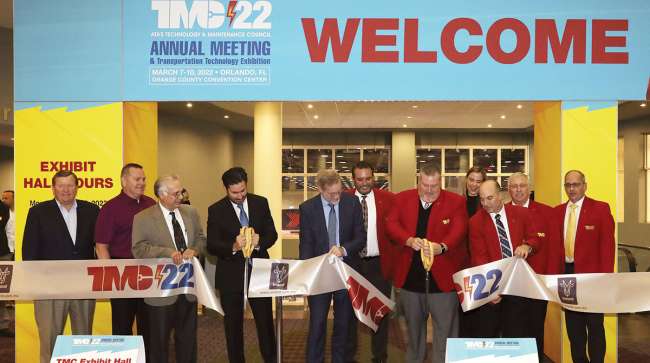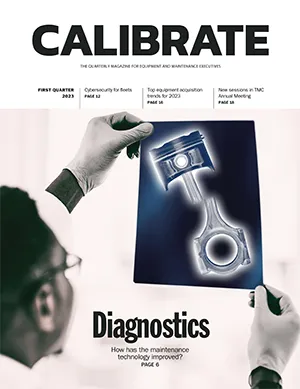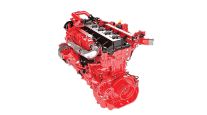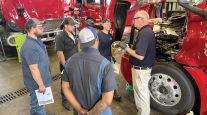Brakes, Telematics Center Stage at Upcoming TMC Annual Meeting

[Find the latest in equipment & maintenance: Explore this quarter's issue of Calibrate]
Brakes and telematics will take center stage at two important technical sessions during TMC’s 2023 Annual Meeting & Technology Exhibition at the Orange County Convention Center in Orlando, Fla., Feb. 27-March 2.
Both sessions — titled “Does the Industry Need an Open Telematics API?” and “A Fresh Look at Aftermarket Brake Lining Classification” — are designed to help educate fleet personnel on important developments in the areas of brake lining classification and the need for a open standard for telematics application programming interface. Based on fleet members’ take on these two issues, TMC’s related task forces will begin crafting new or updated recommended practices to solve the technical challenges associated with each.
Ensuring Compatibility When Selecting Aftermarket Brake Linings Remains Challenging
Replacing brake linings can be tricky business for fleet managers. There are a lot of options available when it comes to specifying the lining material for a vehicle’s first reline, all featuring different performance and cost considerations.
Staying with original equipment manufacturer (OEM) parts is one way to ensure close compatibility with the original lining specification, but it can be a more expensive proposition. Aftermarket linings can be less expensive, and just as capable as OEM offerings, but how does a fleet manager know, since aftermarket friction performance is completely unregulated in North America?

Legler
Safe operation of a heavy-duty air-braked vehicle rides on the driver’s understanding of the characteristics and response of the vehicle in all conditions. Even with a full suite of current advanced driver assistance system (ADAS) technologies on board, a driver must be confident that the vehicle to which they are assigned will respond flawlessly and consistently to drive inputs. The most important element of all vehicle safety is the braking system, which must generate the friction necessary to dissipate the kinetic energy of a fully loaded combination vehicle and bring it to a stop as it was designed to do by the OEM, repeatedly and consistently across the environmental conditions that a driver will face throughout each trip.
As vehicles accumulate time and miles in service, brake linings will need routine replacement. However, specifying aftermarket brake components that will achieve comparable-to-original performance can be challenging. Spec’ing aftermarket brake linings can be a cost-effective and safe option, but it requires understanding the balancing act between cost effectiveness and performance in an essentially unregulated aftermarket.

Braswell
TMC’s S.6 Chassis & Brake Systems study group has reactivated a long-standing task force to review TMC RP 628C, Aftermarket Brake Lining Classification, which was first developed more than 20 years ago to assist fleets in this maintenance challenge by providing a brake classification listing of aftermarket products in cooperation with the SAE International affiliated Performance Review Institute (PRI). Chaired by Ron Moody of Haldex Brake Products, the task force will address technical factors that have arisen since the last revision.
Leaders in the TMC task force will conduct what likely will be intense discussions around the PRI listing and how it may need to be updated to keep it relevant and effective. As more production of aftermarket product has moved offshore over the years, participation in the listing has become more sporadic, and inquiries from fleets into the listing have decreased. RP 628C is effectively the only such resource available to the industry, and the current revision process is seen as pivotal to fleets, especially smaller organizations and independent operators in being able to compare performance against OEM certification to the Federal Motor Vehicle Safety Standard (FMVSS) No. 121, Air Brake Systems.
More Q1 Calibrate
►Technology Helps Technicians Streamline Repairs
►How to Combat a Cyberattack
►Top 10 Equipment Financing Trends Face Headwinds
►Freeze: Ready for the Future
►TMC Corner: Brakes, Telematics Focus of TMC 2023
Explore the Issue!
Another aspect is the impact of regenerative braking on the conditioning of the frictional material due to the loading distribution differences of electric vehicles compared to internal combustion engine-powered vehicles. Brakes for electric vehicles may transition to smaller brakes with more aggressive brake materials. This difference in operating parameters has brake suppliers watching first failure modes very closely, hence; aftermarket friction manufacturers will also need to learn these key lessons to building a successful friction material for these applications. Likewise, the emergence of automated driving systems (ADS) will require that original equipment and aftermarket suppliers alike assess maintenance implications and operations data, and experience grows.
During TMC’s upcoming annual meeting, the S.6 study group will present its findings on the matter during its mini-technical session scheduled for Feb. 28. This session will not only review the various technical aspects of the current marketplace, but will also seek fleet perspectives on RP 628C’s relevance and value to take into account during the current revision debates. Fleet attendance and participation in the session as well as the task force’s working meeting on the subject scheduled for Feb. 27 are deemed vital.
Enabling Artificial Intelligence-Driven Maintenance
Telematics is certainly revolutionizing vehicle maintenance. The amount of information that is now available to fleet managers is astounding compared to just a few short years ago. However, the availability of this information and the technology that is making it possible is providing new concerns to fleets, suppliers, maintenance providers and manufacturers alike.
These issues will be considered under the auspices of TMC’s S.12 Onboard Vehicle Electronics study group, examining the consequences and potential value of TMC recommending an open telematics applications programming interface (OTAPI) protocol as an industry practice. An S.12 task force has been evaluating such a protocol for the last year with the National Motor Freight Transportation Association (NMFTA) in which fleets could specify to the telematics service providers (TSPs) that a common API be used in lieu of proprietary APIs. Consensus for an OTAPI remains elusive at the present, however, particularly among manufacturers.
While a standard OTAPI would not impact the physical storage of data or value of the unique analytic capabilities of the respective TSP, it would facilitate fleets’ ability to pull data in a format that could more readily integrate into back-office systems. This protocol would be very effective in integrating telematics logs and databases across multiple platforms as is the case in mixed-fleet operations and in efficiently combining or disseminating data during fleet mergers and divestitures, as well as across multiple generations of trailer technologies.
Want more news? Listen to today's daily briefing above or go here for more info
The development of Intelligent Vehicle Health Maintenance (IVHM), in which onboard “smart” componentry will be able to accurately and prognostically identify and flag developing maintenance issues in a real-time, on-the-road environment hinges upon the ability of an ever-increasing pool of sensory data to be interchanged across systems and among the intelligent components themselves. The benefits to fleets lie in potential significant future reductions of unexpected failures, downtime and preventive maintenance interval costs, and in the effective transmittal of vehicle safety status to enforcement agencies as automation plays an ever-increasing role in operations. TMC’s Future Truck Committee identifies the breaking of data silos as the most important challenge to the IVHM concept.
TMC’s OTAPI task force will continue its evaluation of the protocols in cooperation with NMFTA, with the technical aspects nearing a final stage. The S.12 study group will also be considering what commitment of time and resources will be needed to operationalize and maintain such a joint effort, should the decision be made to begin the formal process of approving OTAPI as a TMC recommended practice .
A critical part of TMC’s process is getting fleets to affirm the importance and urgency of implementing OTAPI on a national basis. To this end, S.12 will conduct its session on March 1 to answer the question, “Does the Industry Need an Open Telematics API?” Fleet attendance and active participation in this session will provide the vital feedback needed in making the determination to push ahead with OTAPI.
For more information, or to register for TMC’s 2023 Annual Meeting, visit tmcannual.trucking.org.


&uuid=(email))




